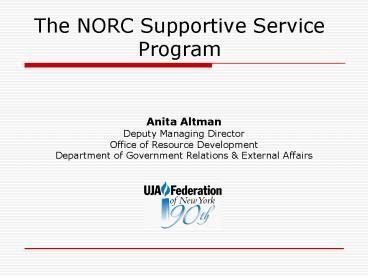The NORC Supportive Service Program - PowerPoint PPT Presentation
1 / 15
Title:
The NORC Supportive Service Program
Description:
... and recreational activities -classes, trips and other group activities which are ... Federation of New York Service Agency. NORC-SSP Resource List. Altman, ... – PowerPoint PPT presentation
Number of Views:45
Avg rating:3.0/5.0
Title: The NORC Supportive Service Program
1
The NORC Supportive Service Program
Anita Altman Deputy Managing Director Office of
Resource Development Department of Government
Relations External Affairs
2
New York City Population
New York City Population data from 2005 Census
Estimate.
Total Population 7,956,113
3
New York City Jewish Population
24
21
22
33
Jewish Community Study of New York 2002, Ukeles
and Miller.
Total Population 1,420,000 New York
Metropolitan Eight County area
4
Key Insights
- Many communities built originally for families
now have high concentrations of seniors, who are
aging in place - Significant numbers and density of senior
residents can provide a critical mass to justify
locating services on-site, where the seniors
live - Effective and efficient services can be organized
to help enable seniors to remain in their own
homes even as they grow older and frailer
5
What is a NORC?
- A NORC is a Naturally Occurring Retirement
Community, - a building, apartment complex, or neighborhood
originally built for families, but in which
overtime a significant percentage of residents
are now seniors
6
Types of NORC SSPs
- Classic (common ownership)
- 45 - 50 residents 60
- minimum 250
- Neighborhood no common ownership
- 40 of residents are 60
- maximum 2,000 seniors
7
In NORC-SSPs Seniors are viewed as
- A resource who have much to contribute from their
life experience - Partners, whose aspirations and needs help to
shape and define the program services - Needing to be deeply involved in the program's
governance.
8
NORC Supportive Service Programs are
- community builders, help to reweave and
strengthen the social fabric of the community - partnerships of social service and health care
providers, housing managers, residents,
government and often philanthropy - developed only after a process of community
assessment - located on-site in the community that is to be
serve
9
NORC Supportive Service Programs are
- do not duplicate existing services, rather
mobilize services for members identify service
gaps, and develop services and programs to meet
them - eligibility to participate is determined by age
and residence, not by ability to pay or
functional status - the community and housing entities must
participate in the governance of these programs - seniors across the age spectrum benefit from the
program
10
Core Services
- Social Work information and referral,
assistance with securing entitlements, case
management, service linkage and coordination. - Nursing educational programs and community
initiatives on prevention and health promotion,
assists individuals with chronic care management,
(services that are not reimbursed through our
Medicare program). - Social and recreational activities -classes,
trips and other group activities which are often
led by seniors themselves. - Volunteer Programs
11
Ancillary Services
- Transportation
- Social Adult Day Care
- Housekeeping
- Financial Management
- Legal Services
12
Leveraged Services
- Geropsychiatric Fellows
- Social Work, Occupational and Physical Therapy
interns - Health Screenings
13
Funding
- Public/Private Parternship
- New York State - 4.2million
- New York City - 6.5million
14
2007
- 54 publicly funded NORC-SSPs in New York State
- 28 led by UJA-Federation of New York Service
Agency
15
NORC-SSP Resource List
- Altman, Anita, (2006). The New York
NORC-Supportive Service Program. Journal of
Jewish Communal Service. 81 195-200. - ASPE, Annotated Review of the Literature on
Housing with Services for Older People Who Age in
Place. (http//www.aspe.dhhs.gov/daltcp/reports/NO
RCsspA1.pdf ) - Masotti et al. (2006). Healthy Naturally
Occurring Retirement Communities A Low-Cost
Approach to Facilitating Healthy Aging. American
Journal of Public Health. 96 1164-1170. - (http//www.ajph.org/cgi/content/full/96/7/1164?ma
xtoshowHITS10hits10RESULTFORMATauthor1Mas
ottisearchid1FIRSTINDEX0sortspecrelevancere
sourcetypeHWCIT ) - University of Albany, NORC Bibliography
(http//www.albany.edu/aging/norc.htm)

